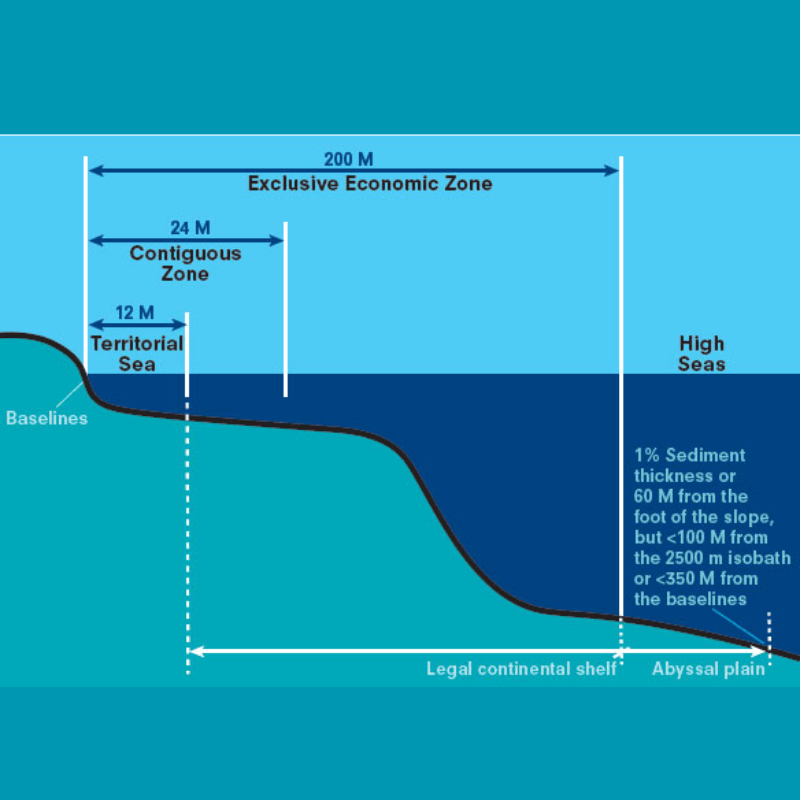 What are UNCLOS Maritime zones? How are they specified? What are the important articles of UNCLOS? Read further to know more.
What are UNCLOS Maritime zones? How are they specified? What are the important articles of UNCLOS? Read further to know more.
Recently, India reaffirmed its support for the UN Convention on the Law of the Sea (UNCLOS).
In accordance with the UNCLOS 1982, India supported unrestricted commerce, freedom of navigation and overflight, and other international legal principles.
India is a UNCLOS state party as well.
Also read: High Seas Treaty
United Nations Convention on the Law of the Sea(UNCLOS)
An international treaty known as UNCLOS, or the United Nations Convention on the Law of the Sea, 1982, lays the legal foundation for marine and maritime operations.
The Law of the Sea is another name for it. The five main zones that separate marine areas are Internal Waters, Territorial Sea, Contiguous Zone, Exclusive Economic Zone (EEZ), and High Seas.
It is the only international agreement that lays forth a structure for state authority in maritime areas. It gives certain maritime zones various legal statuses. It acts as the cornerstone for people travelling through waters as well as the coastal states’ offshore governance.
Along with dividing the offshore territories of coastal nations, it also outlines the duties and privileges of each of the five concentric zones. Although almost all of the South China Sea’s coastal nations have ratified and signed the UNCLOS, its interpretation is still a subject of intense debate. Another maritime conflict is taking place in the East China Sea.
Also Read: COP26: UN Climate Change Conference 2021 – ClearIAS
Maritime Zones under UNCLOS
Under UNCLOS, the oceans are divided into the following maritime zones, each of which has a distinct legal status:
- Internal Waters
- Archipelagic Waters
- Territorial Sea
- Contiguous Zone
- Exclusive Economic Zone
- Continental Shelf
- High Seas
Let us discuss more on these divisions.
Baseline
The low-water line of the coasts as recognised by the coastal state is the maritime zone baseline.
Internal Waters
- Ships must abide by the laws and regulations of the coastal or port State when entering internal seas (Port State Control).
- Internal waters of the State include the seas on the landward side of the territorial sea’s baseline.
- The coastal State also has the right to take the appropriate action to prevent any violation of the conditions governing admission of those ships to internal waters or such a call in the case of ships travelling to internal waters or a call at a port facility outside internal seas.
- There is no right of innocent passage unless territorial sea straight baselines are used to enclose waters that weren’t previously internal waters.
Archipelagic Waters
- The major islands must be included in the archipelagic baselines.
- The sea must be contained inside the archipelagic baselines in an area that is at least nine times smaller than the enclosed land area.
- Except for up to 3% of the total number of baselines encompassing any archipelago, no archipelagic baseline may be longer than 100 nautical miles, with a maximum length of 125 nautical miles.
- The archipelagic baselines must not deviate from the archipelago’s overall layout in any meaningful way.
Territorial Sea
- The territorial sea extends outward 12 nautical miles from its baselines.
- Based on the circle of the planet, a nautical mile (nm) is equivalent to one minute of latitude. It is far farther than a land mile (1 nautical mile equals 1.1508 land miles or 1.85 kilometres).
- The coastal states have sovereign authority over the territorial sea. These rights extend to the seabed, the subsoil, and even the airspace in addition to the surface.
- However, the innocent passage of the territorial sea restricts the powers of coastal governments.
Contiguous Zone
- From its baselines, the contiguous zone extends out to sea up to 24 nautical miles.
- In between the territorial sea and the high seas, it acts as a transitional zone.
- The coastal state has the power to enforce fiscal, immigration, sanitary, and customs regulations within its borders and in its territorial waters.
- In contrast to the territorial sea, the contiguous zone only grants state sovereignty over the ocean’s surface and floor. It doesn’t give anyone the right to fly or explore space.
Exclusive Economic Zone (EEZ)
Each coastal state has the right to an EEZ that stretches up to 200 nautical miles from its baselines, beyond and adjacent to its territorial sea.
The EEZ of a coastal state comprises:
- Sovereign control over the seafloor and subsoil for the aim of identifying, using, protecting, and managing all types of natural resources, whether they be living or not.
- Right to engage in activities like wind, water, and current energy production.
- Contrary to the territorial sea and contiguous zone, the EEZ solely permits the aforementioned resource rights. It does not give a coastal state the authority to restrict or outlaw the freedom of navigation or overflight, with very few exceptions.
Also read: Nord Stream pipeline
Continental Shelf
- The coastal States have exclusive sovereign rights over the continental shelf, which consists of the seabed and subsoil of the underwater areas that extend beyond its territorial sea, in order to explore and utilise its natural resources.
- The seabed and subsoil of the shelf, the slope, and the rise make up the continental margin, which is the submerged extension of the landmass of the coastal State. It excludes the subsoil of the deep ocean floor with its oceanic ridges.
Also Read: Ocean Floor: Everything you need to know – ClearIAS
High Seas
The ocean’s surface and the water column outside of the EEZ are referred to as the “high seas.”
- It is outside any national jurisdiction and regarded as “the common inheritance of mankind.”
- States may carry out operations in these regions so long as they serve peaceful objectives, like transportation, marine science, and underwater exploration.
- The high seas are the ocean’s surface and the water column outside of the EEZ.
- It is outside the purview of any particular nation and is regarded as “the common legacy of all mankind.”
- States are permitted to carry out operations in these regions so long as they serve peaceful objectives, like maritime research and undersea exploration.

3 Important Articles of UNCLOS
- According to Article 3 of the United Nations Convention on the Law of the Sea, every state may claim a territorial sea that extends up to 12 nautical miles (UNCLOS).
- Guidelines for Straight Baselines are provided in Article 7 of the UNCLOS.
- Normal Baseline parameters are provided in Article 5 of the UNCLOS, and the territorial sea’s breadth is described in Article 3 of the UNCLOS.
3 Different UNCLOS Conferences
Geneva, Switzerland hosted the inaugural UNCLOS conference in 1956.
- UNCLOS I: Four accords were drafted in 1958 thanks to UNCLOS, but they didn’t all go into effect until later. The Convention on Fishing and Conservation of Living Resources of the High Seas, the Convention on the Continental Shelf, the Convention on the High Seas, the Convention on the Territorial Sea, and the Contiguous Zone were these four accords.
- UNCLOS II: In 1960, UNCLOS II was held. However, no new treaties were signed as a result of this second meeting.
- UNCLOS III: The Third United Nations Conference on the Law of the Sea (UNCLOS-III) met in New York in 1973 as a result of various territorial water claims made by various countries. Up until 1982, this conference was held. The convention incorporated numerous significant rules, including those for the resolution of disputes, scientific research, deep seabed mining, environmental protection, continental shelf jurisdiction, the exploitation regime, navigation, and exclusive economic zones (EEZs).
Also read: Movements of ocean water: Waves, Tides and Ocean Currents
Conclusion
International law establishes the limits of maritime areas and the rights that various categories of States may enjoy therein. For the purposes of negotiating and establishing the maritime boundary, the legal status of a marine zone, that may be the subject of conflicting claims and pending delimitation, is very important.
Article Written By: Atheena Fathima Riyas






Leave a Reply